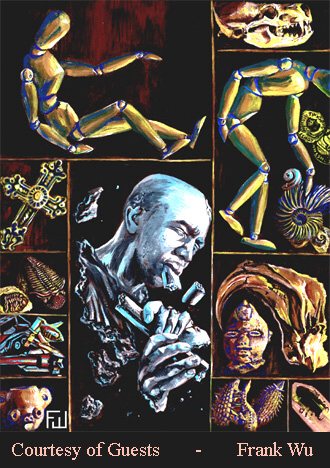
Illo for the story "The Courtesy of Guests." This is for the collection - of my art and Jay Lake's stories - entitled Greetings from Lake Wu, to be published by Wheatland Press.
The book is set to be released in October at the World Fantasy Convention in D.C. but is available for pre-order from Wheatland Press.
The book will also be sold in a special very limited (26 copies!) Box of Wonders edition in a handmade wooden box, with the book, a set of color prints of the illos, a bag of tchotchkes (hand-picked from fossils, crystals, coins, medallions and other cool little bits), the only copy of a one-off story by Jay about a letter from the alphabet, and an accompanying one-of-a-kind illo by me.
This was a fun story to illustrate. The setting is a future earth, but the perspective is looking back on the ancient earth. It seemed appropriate to use as the visual gimmick a drawer in a museum. I have always been curious about the curios in the wooden drawers in the backrooms and basements of great museums. Only the tiniest fraction of their collections are on display. What treasures are hidden away, seen only by scholars and sleep-deprived grad students? Indeed, many recent "discoveries" have been made as scientists got around to cleaning fossils collected long ago. Almost makes me want to become a grad student in paleontology. Almost.
So the question becomes, what sorts of things would people in the far future find in the drawers of their museums? Characters and bits from this story, of course. So we find fragments of a sculpture of Ahrimen, playing his manbone quena. The two wooden figures represent Meschia and Meschiane, also from the story. These are the last people to return to earth, the Homo terminus. However, in a way, they are also an inversion of and commentary on Adam and Eve, as their names are the those of the Persian equivalent of the Biblical first couple.
In the illo two wooden figures - idealized visions of humanity as are Meschia and Meschiane - recreate the poses of Michelangelo's and Rodin's versions of Adam. Michelangelo's Adam (on the left in my piece) lies at rest, receiving the touch of God giving him Life. Rodin's Adam has eaten the forbidden fruit and is bent over in shame and disgrace, cast out of Eden and away from the Tree of Life. But the two are really the same pose rotated ninety degrees. All this theology conveyed by simply giving the figure a quarter turn.
So... What else could I put in my drawer? Images of the past can be used to evoke the future. In the film Things to Come, future scientists wear the togas of ancient Greece. In the future worlds of Gattaca and Brazil, people drive old French and German vehicles. So I have included in my divided drawer, inter alia, a faux antique cross, Roman coins with Constantine's face, Olmec artifacts, fossil ammonites and trilobites, a jumble of plastic ankylosaurs, and toy visions of futuristic airplanes. The past and the future jumbled together; they become indistinguishable on a large enough time scale.
Email to Frank Wu
Image (c) 2003 Frank Wu